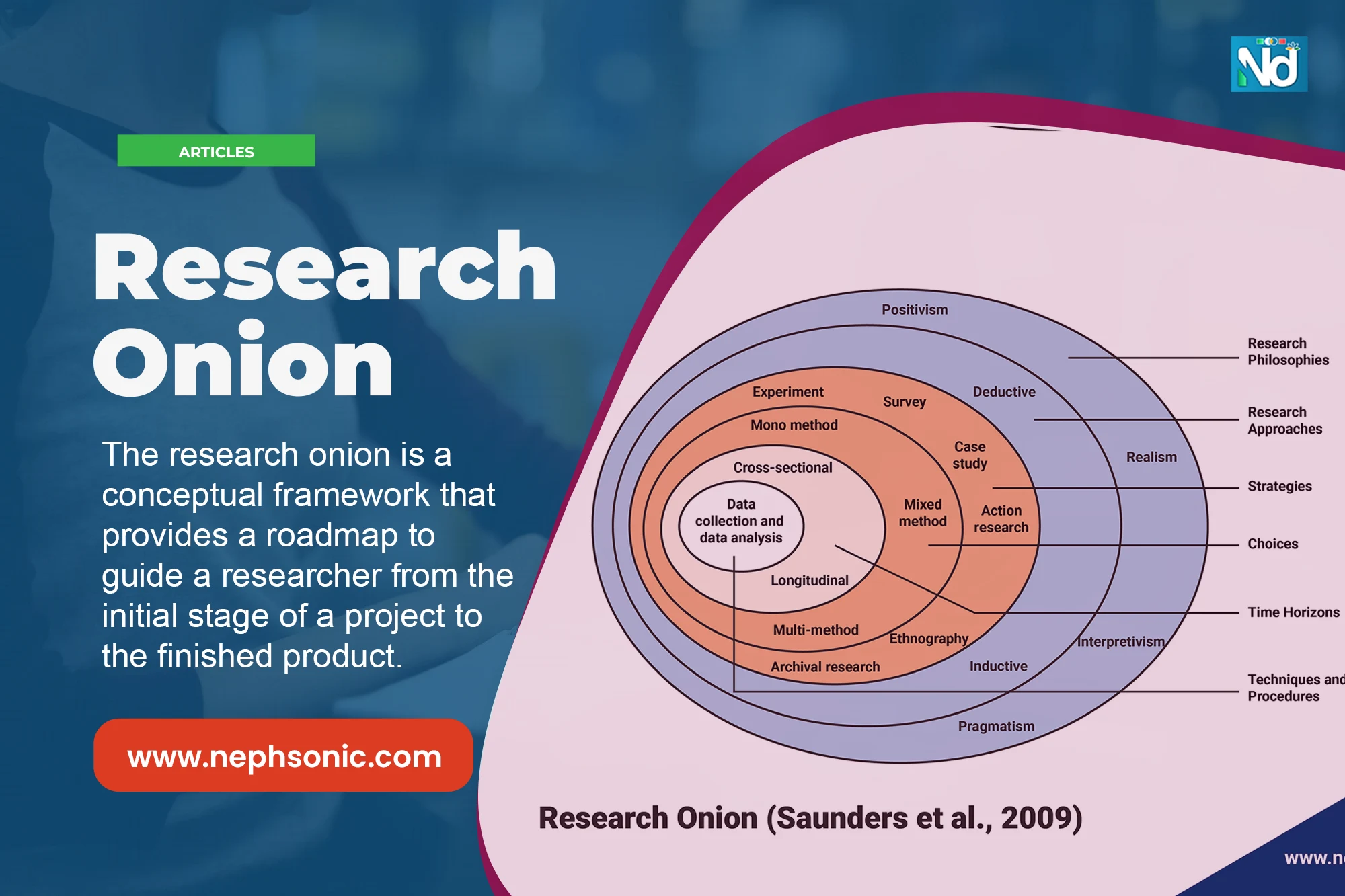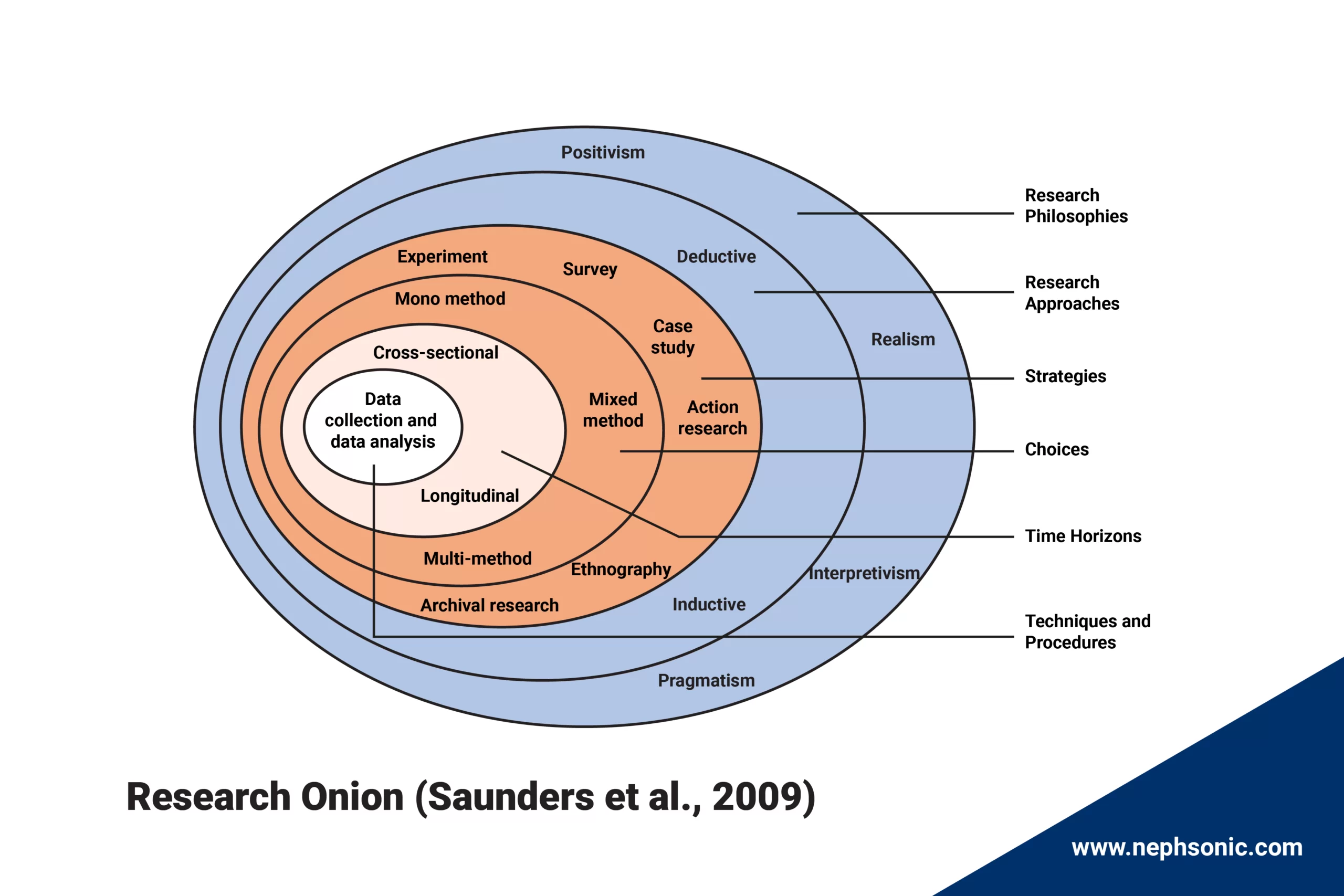Understanding the Research Onion (Saunders et al., 2015)

Understanding the Research Onion (Saunders et al., 2015)
-
By: Nephtali Tshitadi
- Published: Jan. 18, 2024
This article provides a comprehensive guide to understanding and writing a compelling and effective research methodology chapter of your thesis/dissertation, focusing specifically on the research onion framework by Saunders, Lewis, and Thornhill (2016).
Table of Contents
Introduction
Research is an incredibly important tool for understanding and navigating through the world around us. It is defined as a systematic and structured process of gathering data, analyzing information, and drawing conclusions in order to answer research questions or address a specific problem. Research plays a crucial role in shaping policies, decision-making, validating existing ideas, and gaining insights into how the world operates (Sujatha, 2016)
However, conducting research is not an easy task. It often involves a continuous process of inquiry and response, leading to a multitude of questions such as: where do I start from? What research questions should I formulate? What research design or philosophy is best for my study? How do I select the suitable method for data collection/analysis?
Recent statistics show that academic research demands rigorous commitment and resilience. A study by Styger Vuuren and Heymans (2014) revealed that, in South African universities, the dropout rates for Master’s degrees ranged from 30% to 67%, while for doctoral degrees, the rates were between 50% and 68%. Similarly, Bekova and Dzhafarova (2019) reported that the dropout rate for certain Ph.D. programs in Spain ranges 70% to 90%, while in Australia, it was approximately 30%, and around 50% in the USA. Even the most developed European countries face 40% to 50% dropout rate of engineering students during their first year, and the rate can be as high as 80% for some engineering disciplines (Sultana et al., 2017; Kabashi et al., 2022).
The high dropout rates for postgraduate students can be attributed to a multitude of factors, including individual, institutional, and sociodemographic considerations.
Individual-related factors such as mental health, regret, anxiety, and age have been identified as potential contributors to dropout intentions among postgraduate students (Peng et al., 2022; Nadeem & Palaniappan, 2021). Additionally, the demanding nature of postgraduate studies, inadequate research preparation, and insufficient institutional and financial support have been highlighted as intrinsic (student-related) and extrinsic (institutional-related) factors influencing dropout rates (Cobbing et al., 2017). Furthermore, gender disparities and educational equality have been associated with higher dropout rates among postgraduate female students compared to their male counterparts (Alabi et al., 2019). Socioeconomic factors, such as the cost of education and economic background, have also been recognized as influential in student dropout from postgraduate studies (Nadeem, Palaniappan & Haider, 2021).
Furthermore, institutional factors, such as inexperienced and overburdened supervisors, inadequate research preparation, and insufficient institutional and financial support, have also been recognized as contributors to the high dropout rates for postgraduate students (Cobbing et al., 2017; Styger et al., 2014). Furthermore, the lack of adequate computer literacy, typing skills, and effective internet usage among postgraduate students has been identified as a challenge, particularly in the context of coursework and research (Havenga & Sengane, 2018).
The lack of proper guidance or academic counseling is yet another factor that has been identified as a significant obstacle contributing to the dropout rates of postgraduate students (Schmidt & Umans, 2014; Deri, 2022). Without proper career guidance or academic counseling, students may find themselves in courses that do not align with their interests or career aspirations, leading to dissatisfaction, prolonged or non-completed studies (Schmidt & Umans, 2014) and, eventually, dropout. Additionally, the lack of experience and competencies in academic writing has been cited as a barrier to progression for PhD students (Litalien & Guay, 2015).
However, despite the complexity and challenges of conducting research, it is important to highlight that there are many resources and tools available to help researchers navigate the process and write a compelling and effective research methodology chapter. One such resource is the research onion framework (Saunders et al., 2016), which provides a comprehensive structure for conducting research and effectively organizing the methodology chapter. The framework provides a roadmap to guide a researcher from the initial stage of a project to the finished product.
In this comprehensive article, we will delve deeper into the research onion framework and explore in detail how it can be effectively used to write a compelling research methodology chapter for your dissertation/thesis. We will also discuss some common misconceptions about research methods and how understanding the onion can help researchers avoid these errors.
1. Defining the Research Onion
The research onion is a concept that describes the stages of planning and designing a research project. It is a metaphorical model used in research methodology to illustrate the various layers or stages involved in the research process. It is based on the idea of layering, with each layer representing a different stage of the research process.

As the word suggests, this process is similar to peeling an onion; as you go deeper into your research project, you will see more layers that need to be peeled off before reaching the core of your data analysis. Each layer of the onion represents a different step in the process of conducting research, and each step builds upon the previous one. The main idea behind the research onion is that researchers need to understand how their decisions at each stage can affect the quality and validity of their findings.
The concept was first developed by Saunders, Lewis, and Thornhill (2009) to visualize the research process and the various stages researchers must go through to achieve a successful outcome.
The research onion consists of six layers: (1) the research philosophy, (2) the research approach, (3) the research strategy, (4) the research choice, (5) the time horizon, and (6) the data sources. Each layer of the onion has a unique purpose and is fundamental to the success of a research project. The overall research will likely suffer if any of these layers is neglected. Therefore, researchers need to understand the research onion concept and how the layers interact with each other. This understanding can give them the confidence to accurately plan, design, and execute their research projects and ensure that the results are valid and reliable.
2. The Research Onion's Layers
The diagram below shows the structure of the onion and how each layer provides a different perspective on the research process:

2.1. Research Philosophies
The first layer of the research onion is the research philosophy. This is the outermost layer and represents the researcher’s underlying philosophical beliefs and assumptions. Research philosophy is about how you view the world. It includes your beliefs about the nature of the truth you are investigating: WHAT is important, and WHY is it important?
As such, the researcher should be able to answer the following questions: what personal values do you bring to the topic? How will they influence your choice of methodologies and procedures? What impact might they have on the validity of your results? Bajpai (2011) suggested the research philosophy helps you decide what types of data to collect, how to collect it, and how to analyze it.
Academic studies frequently adopt four distinct philosophical orientations in research: positivism, interpretivism, pragmatism, and realism (Saunders et al., 2007; Žukauskas, Vveinhardt, & Andriukaitienė, 2018).
1.1. Positivism
Positivism is based on the assumption that the world is objective and that scientific methods are the best way to understand it. The advocates of positivism support the idea of objectivism. In other words, reality can be known objectively through systematic observation and measurement. From this viewpoint, researchers are considered objective observers who examine phenomena that are independent of them (Rehman and Alharthi, 2016). They use symbols and words to describe things as they exist without any interference (Rehman & Alharthi, 2016).
The positivist approach is fundamentally rooted in scientific methods, diligently attempting to explain the underlying causes and effects of various phenomena. It is particularly well-suited for quantitative studies, where researchers employ techniques such as surveys, experiments, and simulations to rigorously gather and analyze data (Holden & Lynch, 2004).
1.2. Interpretivism
Interpretivism focuses on understanding human behaviour by closely examining people’s experiences, interpretations, and perspectives (Bajpai, 2011). The advocates of positivism support the idea of subjectivism. They believe reality is subjective and there are no universal truths (Saunders et al., 2009). This means truth must be created and interpreted subjectively. Individuals must make sense of their own experiences to understand and interpret the world around them. Interpretivism often uses qualitative methods such as interviews, focus groups and observations to collect data (Bajpai, 2011).
1.3. Pragmatism
Pragmatism is a philosophical approach that emphasizes practicality or usefulness as the ultimate criterion for judging truth (Saunders et al., 2009). In other words, pragmatism is committed to using evidence and reason to determine what works best in the real world. It focuses on practical outcomes rather than abstract theories. Pragmatist researchers believe in the efficacy of using practical experience and empirical evidence to determine the truth or falsity of propositions.
The meaning of concepts or ideas cannot be ascertained apart from their use in the context of actual situations. Pragmatism is often contrasted with the epistemological perspective, which holds that knowledge can be derived from a source independent of experience. The following research methods are commonly associated with Pragmatism: empirical observation, experimentation, and survey research.
1.4. Realism
Realism is a philosophical position that believes that the world is fundamentally the same as it is in reality and that the only thing that really matters is what is real. Researchers who adhere to this view believe that there are facts out there that exist independently of human thought or perception. While our perceptions may influence what we observe, ultimately the real world exists outside of our experience or belief. As a result, science can provide us with knowledge about these objective realities (Bajpai, 2011).
Despite the inherent disparities among these philosophical approaches, it’s important to note that one isn’t inherently superior to the others. Instead, researchers may tend to gravitate towards a particular philosophy based on their preferences and the nature of their research (Podsakoff et al., 2012).
2.2. Research Approaches
The second layer of the research onion is the research approach. The onion suggests that a research approach must be selected once the appropriate methodology is chosen.
According to Saunders et al (2015), there are two main approaches to research: inductive and deductive.
2.1. Inductive research
Inductive research is a type of inquiry that starts with specific observations or experiences and then generalizes them to form theories or hypotheses. The inductive approach is based on interpretivism (Temitope and Udayangani, 2015). This means that the researcher uses his or her personal experiences, observations, and knowledge to form theories that explain the phenomenon being studied. For this reason, inductive research is often considered a more qualitative approach than deductive research.
For example: suppose you are interested in how people use social media to learn about products. In that case, you might start by collecting data through surveys or interviews, asking people about their experiences buying products online or offline and then draw conclusions based on those interviews. We can see here that the researcher goes from specific to general levels of focus.
As outlined by Bryman and Bell (2011), the inductive approach is predominantly employed in qualitative research. This is particularly advantageous because it obviates the necessity for a guiding theory, which, in turn, diminishes the likelihood of researcher bias during the data gathering phase.
Figure 2 below provides a visual representation of the procedural steps entailed in conducting research utilizing an inductive approach:

2.2. Deductive research
Deductive research starts with a hypothesis or theory that has been established by previous research and then seeks evidence to support or reject it. Here, the researcher goes from general principles to make predictions about what will happen in a specific situation. This approach is based on positivism, i.e. the researcher uses objective methods to gather data from many sources in order to make generalizations about human behavior.
2.3. Research Strategies
2.4. Methodological Choices
2.5. Time Horizons
2.6. Data Collection & Analysis techniques
Common Mistakes to Avoid
Conclusion
References

Nephtali Tshitadi
Nephtali Tshitadi is a researcher and professional content writer with more than 5 years of experience. He holds a Masters's qualification (Mcom) in Finance, Honours Degree in Financial Management, and BCom in Economics.


